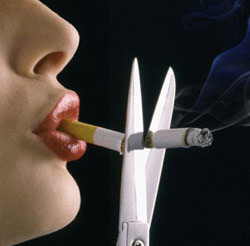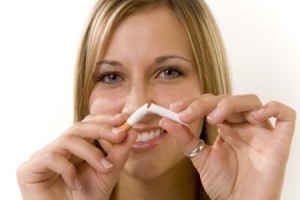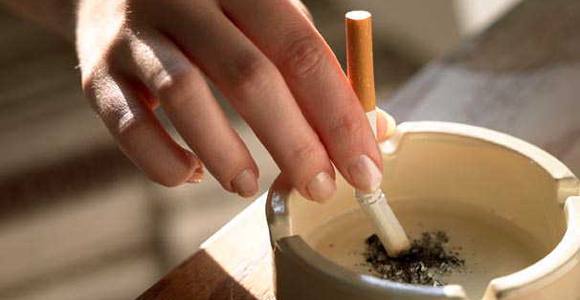 That couplet, written by Charles Lamb 172 years ago, sums up succinctly how I had come to feel about my smoking habit. The tensions of my demanding job as a Hong Kong advertising executive had me lighting up 30 cigarettes a day. I coughed every few minutes. My hands shook. I had trouble breathing in crowded places. After a hectic business trip, my digestion would be upset. I couldn’t sleep when I most needed it. I knew I had to do something. Besides, I had read the convincing statistics on smoking and such related afflictions as lung cancer and heart disease. I tried anti- smoking pills, but they didn’t work.
That couplet, written by Charles Lamb 172 years ago, sums up succinctly how I had come to feel about my smoking habit. The tensions of my demanding job as a Hong Kong advertising executive had me lighting up 30 cigarettes a day. I coughed every few minutes. My hands shook. I had trouble breathing in crowded places. After a hectic business trip, my digestion would be upset. I couldn’t sleep when I most needed it. I knew I had to do something. Besides, I had read the convincing statistics on smoking and such related afflictions as lung cancer and heart disease. I tried anti- smoking pills, but they didn’t work.
When my mom, who had become worried about my health, read about the Seventh Day Adventists’ Five-Day Plan to Quit Smoking, she urged me to give it a try. I was skeptical until I learned that in five years the Adventists’ detoxification techniques had helped rid more than 500 Hong Kong smokes of the tobacco habit. Perhaps with the Adventists I had a chance.
A few days later, I attended the first of five one-and-a-half hour evening sessions at the Adventists’ hospital on Hong Kong island, (The Adventists, a religious sect, maintain hospitals in many Asian countries. See Box) The meeting was scheduled to start at 8:00 p.m. I arrived ten minutes early and found 25 other hopefuls already there. Dr. Sydney Kettner and Pastor Walter Melashenko, organizers of the plan, welcomed us and lost no time in getting the discussion going in a friendly atmosphere. They probed our individual problems, our areas of strength and vulnerability. We soon knew that to beat the common enemy, we would need every fraction of our willpower and mutual encouragement.
The lights in the hall went out. The first shock: a color film entitled “I’m Sorry, Baby,” showing the appalling harm pregnant women who smoke do to their babies. Heavy smoking by an expectant mother causes as much as a 30 percent reduction in placental oxygen. And nicotine and other harmful substances, including carcinogens, in a cigarette, are transmitted through the mother’s blood directly to the fetus, causing possible congenital damage. I saw several women fumbling in their purses for cigarettes, but this time they did not pull them out.
The next shock: a film entitled “Time Will Pull the Trigger.” Tar and other posons in a cigarette were distilled by a smoking machine into a test tube and then injected into a white rat. Within seconds, the rat was dead. Next we saw a patient undergoing surgery for the removal of a cancerous lung. The operation and the deteriorated condition of the lung were horrible to witness. We were all relieved when the lights went on again.
 “Of course,” Dr. Kettner assured us, “this sort of thing isn’t going to happen to all of you.” He pointed out, however, that if we went on smoking, cancer could well be the result. One out of eight men who smoke tow packs a day will end up with lung cancer as opposed to only one of 270 nonsmokers. Said Dr. Kettner, “Smoking strips five to nine years off you lives.”
“Of course,” Dr. Kettner assured us, “this sort of thing isn’t going to happen to all of you.” He pointed out, however, that if we went on smoking, cancer could well be the result. One out of eight men who smoke tow packs a day will end up with lung cancer as opposed to only one of 270 nonsmokers. Said Dr. Kettner, “Smoking strips five to nine years off you lives.”
The doctor then outlined the general plan: The best way to kill the habit once and for all was to stop smoking there and then. We were to disregard stories that a sudden stop could produce harmful consequences. A diet and some simple exercises were all that the body needed to adjust to the sudden change. “If you can hold out for five days,” said Dr. Kettner. “you can hold out forever.”
For the first day, I was recommended a fluids-only diet, especially fruit juices rich in Vitamin B1 and C, to flush nicotine and other toxic matters out of the body. I was urged to avoid alcohol, coffee and tea – all stimulants which could revive the craving for tobacco. To keep myself alert, I was to retire early, take a walk before going to work, practice deep breathing and in general, take in as much oxygen as possible.
“What we need in non-wavering resolution,” Pastor Melashenko told us. “Say ‘I choose not to smoke’ and stick to your decision. From now on, be the caption of your life, not the slave of lethal nicotine.”
The evening ended with a ritualistic climax, as each of us dropped our cigarettes, pipes, tobacco pouches and cigarette lighters into a coffin-like box, symbolizing our farewell to a fatal addiction.
To help us wage war against the habit, we were each given a “battle comrade.” Mine was a transportation worker, an ex-boxer whose strength had been vitally impaired by excessive tobacco. I talked with him over the phone the very first evening. “It’s the most difficult bout I ever fought,” he said, “but it’s one I’m determined to win.”
Nicotine took its revenge the next day. During the morning coffee break, my smoking colleagues teasingly offered me a selection of choice cigarettes. I stood firm, gulped down several bottles of grapefruit juice and returned to work. The next trial came when I had a meeting with a client who is a chain-smoker. When the smoke filled room became unbearable, I proposed a break, opened the windows and inhaled deeply. When the meeting reconvened, something extraordinary happened: My usual coughing and handquivering had decreased. I could feel growing confidence that I was going to make it. Already I felt the first blessings of the ex-smoker.

It was glorious attending the second session. I noticed that on every side people were encouraging each other. This is important, because mutual support is fundamental to the Adventist’ cure. Except for one lady who smoked again after she had had a cocktail, the rest of us won the battle-for the day.
On this particular evening, Dr. Kettner concentrated on the ill-effects of smoking on the heart. Cigarettes induce a reduction of five to ten percent of oxygen intake; they also increase the deposit of cholesterol and other lipids within the inner walls of the arteries, promoting atherosclerosis, which can gradually lead to thrombosis. “For smokers, the risk of sudden death from heart disease is three to five times that for non-smokers,” he warned.
The following day was the hardest to get through. Bitter memories of past failures rushed to my mind. I felt desperate and lost, and the craving for “just one more cigarette” was almost overpowering. Following the advice of the plan, I fiddled with a pencil and chewed gum to check the itchiness in my fingers and the craving of my lips. Whenever I felt about to give in, I looked at my watch and smoke in the next 60 seconds.” At the end of the 60 longest seconds in my life, I repeated with stronger insistence, “I choose not to smoke for one more minute.” By the time three minutes were up, the peak of the irresistible urge had passed. When I went home from work that day, I enjoyed the triumphant feeling that I was acquiring unquestioned control over my actions.
It was not until I got to the hospital later that evening that I learned that depression usually sets in on the third day. Many of my comrades had been in low spirits and had other mild withdrawal symptoms such as headaches, but there was reassurance in the knowledge that everyone was undergoing the same ordeal. Advised Pastor Melashenko, “If you’re used to sitting in a particular chair when you smoke, stay away from it. Keep clear of heavy smokers. Skip that favorite TV program if you must smoke while you watch it. Take frequent showers and rub your skin vigorously to stimulate circulation. A void tense situations and major decisions in your work. And watch out for small annoyances; they can trigger strong cravings for a cigarette.”
By comparison, the fourth day was easy. I was beginning to reap the benefits of the cure myself. I breathed easily, and my breath was fresher. With the taste-buds in my tongue coming back to life, I began to relish the food placed before me.
Encouraged by the results, most of the members of my group renewed their determination to stick to our resolution. There were two defections. For the rest of us, there was Pastor Melashenko’s reassurance: “For you, the fight is won. And don’t worry about the other two. They’ll be back.”
On the fifth day, we were allowed to relax somewhat-seeing friends who smoked, returning gradually to a normal diet. In our last session, the atmosphere was joyful. We were overwhelmed by the idea of having spent five days without smoking. Only occasionally did anxiety surface: How long could we keep it up? (Although 95 percent of my group managed to hang on until the end of the plan, 35 percent would take up smoking again by the end of one year.)
Our other big problem was gaining weight. Dr. Kettner recommended diets and reassured us by explaining that our weight would drop back to normal as soon as we really had lost the desire to smoke, for which we compensated by eating.
In the next three months, we had monthly meetings to exchange views on how we could lose entirely any residual desire for tobacco. We were told that, if we really felt ourselves weakening, we could always phone the organizers for individual guidance. I have never had to take advantage of the invitation. Of course, I suffered, but I held on.
Today, I am still enjoying the fruits of my battle of two years ago. My cigarette cough has completely disappeared. All signs of nervousness have vanished. My confidence is growing. I sleep well, and my memory has improved. The air I breathe seems fresher, the food I eat tastes better. In short, with better health, I enjoy life more.
One the last evening of the plan, along with others, I signed a “decision card” which declared, “Because I believe tobacco is detrimental to my health, and illness due to smoking would both jeopardize the security of those I love and hinder further service to my community, I hereby choose to cease smoking from this day forward.” It was one of the best pledges I have ever made.
Anti-Smoking Centers in Asia
Korea
Busan Adventist Hospital
Su-Gu, Busan, Korea
Telephone: (6) 7151-4
Seoul Adventist Hospital
Seoul, Korea
Telephone: 96-0191-8
Japan
Tokyo Sanitarium-Hospital
Suginami-ku, Tokyo 167
Telephone: 392-6151
Kobe Adventist Hospital
Kobe 651-13 Japan
Telephone: 978-989
Okinawa
Adventist Medical Center
Naha, Okinawa
Telephone: (0988) 220107
Taiwan
Taiwan Sanitarium and Hospital
Taipei, Taiwan 105
Telephone: 778151-4
Hong Kong
Hong Kong Adventist Hospital – Stubbs Road
Telephone: 746211
Hong Kong Adventist Hospital Hospital – Tsuen Wan
New Territories, Kowloon
Telephone: 12-403386
Philippines
Bacolod Sanitarium and Hospital
Taculing, Bacolod City
Telephone: 2-10-59
Cagayan Vellay Sanitarium and Hospital
Mabibi, Santiago, Isabela
Telephone: 238
Calbayog Clinic
P.O. Box 6, Calbayog City, Samar
Gingoog Community Hospital
Gingoog City, L-308
Telephone: 150
Manila Sanitarium and Hospital
1975 Donada Street, Pasay City
Telephone: 50-00-61
Miller Sanitarium and Hospital
400 Tres de Abril Street, Cebu City
Telephone: 7-58-33, 9-70-04
Mindanao Sanitarium and Hospital
Tibanga, Iligan City, Mindanao M-104
Telephone: 2-04-32, 2-01-88
Mountain View College Health Service Clinic
Bukidnon, Mindanao
Philippine Union College Health Service
College Place, Caloocan City
Telephone: 25-49-90
Thailand
Bangkok Adventist Hospital
430 Pitsanuloke Road, Bangkok, 3
Telephone: 811422
Phuket Mission Hospital
23 Dibook Roaad, Phuket
Telephone: Hospital 836; Clinic 149
Hat Yai Mission Hospital
Hat Yai, South Thailand
Telephone: 44139, 43139
Malaysia
Penang Adventist Hospital
465 Burmah Road, Penang
Telephone: 24134
Singapore
Youngberg Memorial Adventist Hospital
Singapore 13
Telephone: 889-271
Indonesia
Bandung Adventist Hospital
Jin. Cihampelas 139, Bandung, Java
Telephone: 82091, 82092